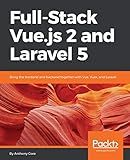Best Laravel Vue.js Integration Guides to Buy in October 2025
To pass user data into Vue.js in Laravel, you can either use props or inline attributes. One way to pass data is by using props in the parent component and then passing them down to the child components. Another way is to use inline attributes in the template tags to pass data directly to the components. You can also use the v-bind directive to bind data to attributes in Vue.js components. Within Laravel, you can retrieve user data from the backend and then pass it to your Vue components using these methods.
How to retrieve user data in Vue.js?
In Vue.js, you can retrieve user data by using data binding and props. Here are a few ways to retrieve user data in Vue.js:
- Data binding: You can use the v-model directive to bind user input to data properties in your Vue instance. For example, you can bind an input field to a data property like this:
data() { return { userData: '' } }
- Props: If you are passing data from a parent component to a child component, you can use props to retrieve the data in the child component. In the parent component, you can pass the data like this:
In the child component, you can then retrieve this data using props:
props: ['userData']
- Event handling: You can also retrieve user data through event handling. For example, you can capture user input in a form and then handle the input data in a method:
<input @input="handleInput" placeholder="Enter your data"> <button @click="submitData">Submit
data() { return { userInput: '' } }, methods: { handleInput(event) { this.userInput = event.target.value; }, submitData() { console.log(this.userInput); // do something with the user input } }
These are just a few ways to retrieve user data in Vue.js. Depending on your specific use case, you may need to use one or more of these methods.
What is the best practice for passing user data into Vue.js in Laravel?
There are a few different ways to pass user data into Vue.js in Laravel, but one of the best practices is to use props. Props allow you to pass data from a parent component to a child component in Vue.js.
Here's how you can pass user data into Vue.js using props in Laravel:
- In your Laravel Blade file, you can use the @json directive to pass the user data to your Vue component as a prop. For example:
- In your Vue component, you can define a prop called userData to receive the user data. For example:
export default { props: ['userData'], ... }
- You can now access the user data in your Vue component using the userData prop. For example, you can display the user's name in the component template like this:
By using props to pass user data into Vue.js in Laravel, you can maintain a clear separation between your frontend and backend code, making your application more modular and easier to maintain.
How to pass user data as global variables in Vue.js?
There are a few ways to pass user data as global variables in Vue.js:
- Use Vuex: Vuex is a state management pattern library for Vue.js applications. You can store user data in the Vuex store and access it globally in your components.
- Use Vue prototypes: You can use Vue prototypes to define global properties or methods that can be accessed in all components. For example, you can set a user property on the Vue prototype and access it in your components using this.$user.
- Use Vue mixins: Mixins are reusable functionalities that can be added to Vue components. You can create a mixin that sets user data and then add it to all your components.
- Use Vue plugins: You can create a Vue plugin that sets user data on the Vue instance. This data can then be accessed in all components via the Vue instance.
Overall, Vuex is the recommended approach for managing global state in Vue.js applications, so consider using it if you need to pass user data as global variables.



